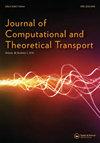Comparing Kinetic and MEP Model of Charge Transport in Graphene
IF 1.1
4区 工程技术
Q3 MATHEMATICS, APPLIED
Journal of Computational and Theoretical Transport
Pub Date : 2020-11-09
DOI:10.1080/23324309.2020.1822870
引用次数: 3
Abstract
Abstract Graphene has attracted the attention of several researchers because of its peculiar features. In particular, the study of charge transport in graphene is challenging for future electron devices. Usually, the physical description of electron flow in graphene given by the semiclassical Boltzmann equation is considered to be a good one. However, due to the computational complexity, its use in simulation tools is not practical and, as already done for traditional semiconductors such as Si or GaAs, simpler models are warranted. Here we will assess the validity of a class of hydrodynamical models based on the maximum entropy principle (MEP), by comparing, in the case of suspended monolayer graphene, the direct solution of the semiclassical Boltzmann equation for electrons, obtained by employing a discontinuous Galerkin approach, with the MEP distribution function. A reasonable agreement is observed.石墨烯中电荷输运动力学模型与MEP模型的比较
石墨烯以其独特的特性引起了许多研究者的关注。特别是石墨烯中电荷输运的研究对未来的电子器件具有挑战性。通常,用半经典玻尔兹曼方程来描述石墨烯中的电子流被认为是一个很好的描述。然而,由于计算的复杂性,它在模拟工具中的使用是不实际的,并且,正如已经对传统半导体(如Si或GaAs)所做的那样,需要更简单的模型。在这里,我们将评估一类基于最大熵原理(MEP)的流体动力学模型的有效性,在悬浮单层石墨烯的情况下,通过使用不连续伽辽金方法获得的电子半经典玻尔兹曼方程的直接解与MEP分布函数进行比较。一个合理的协议被遵守。
本文章由计算机程序翻译,如有差异,请以英文原文为准。
求助全文
约1分钟内获得全文
求助全文
来源期刊

Journal of Computational and Theoretical Transport
Mathematics-Mathematical Physics
CiteScore
1.30
自引率
0.00%
发文量
15
期刊介绍:
Emphasizing computational methods and theoretical studies, this unique journal invites articles on neutral-particle transport, kinetic theory, radiative transfer, charged-particle transport, and macroscopic transport phenomena. In addition, the journal encourages articles on uncertainty quantification related to these fields. Offering a range of information and research methodologies unavailable elsewhere, Journal of Computational and Theoretical Transport brings together closely related mathematical concepts and techniques to encourage a productive, interdisciplinary exchange of ideas.
 求助内容:
求助内容: 应助结果提醒方式:
应助结果提醒方式:


